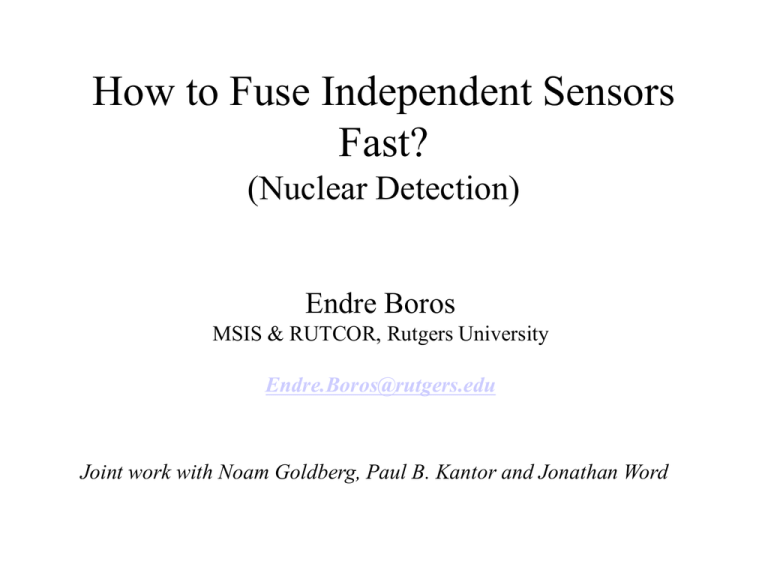How to Fuse Independent Sensors Fast? (Nuclear Detection)
advertisement

How to Fuse Independent Sensors
Fast?
(Nuclear Detection)
Endre Boros
MSIS & RUTCOR, Rutgers University
Endre.Boros@rutgers.edu
Joint work with Noam Goldberg, Paul B. Kantor and Jonathan Word
Statement of Problem
The Problem:
There are several tests that can be applied (document checks, passive
and active sensors of several kinds). Find the “optimal” detection
policy based on these tests! [Multiple branching + policy mixing!]
2
Assumptions and Complexity
• Stochastically independent non-repeated sensors
s
k
• s sensors, k labels at each: >> 2 policies
sensors
labels
policies
4
2
>> 216
4
5
>> 2625
8
2
>> 2256
• Futility of heuristic searches!
3
Move to a decision support model:
Minimize total damage over all available policies
MinP C(P) + πK(1- Δ(P))
Δ(P), C(P) - detection rate, and operating cost of policy P
π (~ 0), K (~very large) - a priori probability of a “bomb”, and expected cost of false negative
MaxP {Δ(P) | C(P) ≤ B }
1
0.9
mixing and domination of policies
0.8
Detection
0.7
concave envelope of best policies
0.6
0.5
0.4
0.3
0.2
0.1
0
0
0.1
0.2
0.3
0.4
0.5
0.6
0.7
0.8
0.9
Cost
4
1
Dynamic Programming: Sensor Fusion
Fusing sensor k on top of the given policies optimally
is a multi-knapsack problem that can be solved by
a modified greedy algorithm:
Greedy Algorithm
Detection
Sensor
k
Cost
Dynamic Programming: common concave envelope
We then merge the given policies with the best combination of
them with sensor k on top – and generate the common
concave envelope of all these policies
Greedy Algorithm
Detection
Sensor
k
Cost
Dynamic Programming: Summary
• We build the concave envelope of best possible policies
constructible from the given set of s sensors.
• We solve s2s sensor fusion problems (for up to s ≤ 20)
• Each Sensor Fusion can be solved in O(P*B+Plog(P))
time, where B is the number of channels of the top sensor,
and P is the number of pure strategies on the effective
frontier.
What about approximating the output in each step?
Stroud and Saeger sensors (4 sensors, ~100 labels each)
Time (sec) Number of Policies
Max. Relative Error %
1440
52319
0.005%
3.53
204
0.05%
0.61
33
0.5%
1.33 GHz Intel Atom processor
8
Extremal frontier with 33 undominated policies
9
Detection = 81.527%
Cost = 0.1977826 units = $11.867 (< $13+)
2
1
R
3
3
R
1
4
R
R
I
4
4
R
R
I
1
1
R
I
I
4
R
I
I
Publications
•
•
•
1.
Goldberg, N., Word, J., Boros, E. & Kantor, P. (2008). Optimal
Sequential Inspection Strategies. Annals of Operations Research Vol. 187,
2011.
2.
Boros, E., Fedzhora, P.B., Kantor, P.B., Saeger, K., & Stroud, P. Large
Scale LP Model for Finding Optimal Container Inspection Strategies. Naval
Research Logistics Quarterly, Vol. 56 (5), 404-420, 2009.
3.
Kantor, P.B. & Boros E. Deceptive Detection Methods for Optimal
Security with Inadequate Budgets: the Screening Power Index. Risk Analysis
Vol. 30, 2010.




